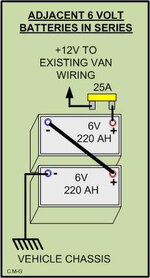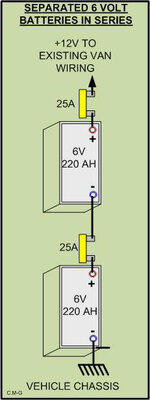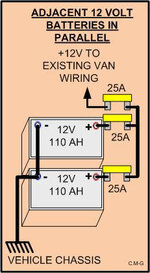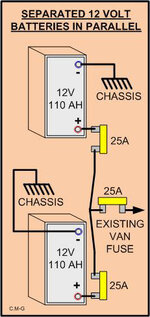scotjimland
LIFE MEMBER
- Jul 25, 2007
- 2,246
- 9,758
- Funster No
- 15
- MH
- A Woosh bang
Thinking of a second leisure battery... ?
This is from an RV article and gives the basics ...
This is from an RV article and gives the basics ...
Paralleled batteries are best if they are of similar age, ampere-hour capacity and construction. That is, one does not connect a Maintenance free (Gell or AGM) battery in parallel with a wet electrolyte battery. Indeed if one wants to fit two batteries in parallel its best if they are purchased together as a pair.
However if one is in this situation its even better to purchase two 6 volt batteries and connect them in series. If these batteries are not adjacent then the linking cable must be protected with an additional fuse.
However, most of us tend to end up wanting to supplement what we already have with a bit extra! Although not ideal paralleling two not quite similar batteries will provide a significant gain and is commonplace, but you must not mix types and need to be aware that an old failing battery will pull down a new battery.
One other detail to be aware of. Its quite a surprise when you make the final connection if a significant spark takes place at the moment of making the connections touch. The moral here is to make sure BOTH batteries are in the same state of charge, the easiest way is to ensure that both are fully charged first!
If the two batteries to be connected in parallel are mounted directly alongside each other then traditionally it was OK to fit two short stout cables or copper links to join the negatives together and the positives together. The original single fuse being sufficient. However modern considerations take account of one of the pair of paralleled batteries suffering from an internal short within a cell which could cause a high current to flow from the "good" battery to the one with an internal cell short. For this reason it is safest if each battery is fitted with its own individual fuse to provide protection against this scenario.
If paralleled batteries are mounted in different places then a fuse for each battery is normal anyway.
The negative for the second battery being connected with a stout wire to the closest chassis point.
When working on battery systems always disconnect the NEGATIVE connection to the battery first. If you have more than one battery be aware that the potential for spanner induced earth (chassis) faults exists until the penultimate connection has been removed.
The fuse and cable sizes shown on the diagrams are notional. That is you need to consider your existing wiring and ensure that any wiring added is at least of the same copper cross sectional area (thickness) and that fuses are of the same current (amps) rating.
If cable runs are long then increase the cable size anyway to reduce voltage drop.
If you have added powerful accessories like an inverter capable of running a microwave oven for example then any battery wiring and fuses must be appropriate.
For example an 800 watt rated microwave oven will actually consume more like 1500 watts so via an inverter will be drawing approximately 140 amperes. Cable sizes could be 35 sq mm and fuses rated at 200A.





